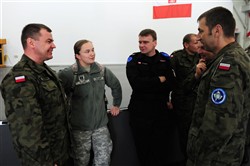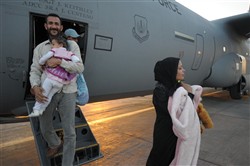Serbian agencies test emergency response skills in disaster exercise
Related Topics (4)
More related topics
BELGRADE, Serbia — Representatives from Serbia’s Ministry of the Interior, Sector for Emergency Situations, and the Ministry of Defense, participated in a disaster response workshop and tabletop exercise held May 10-14, that was facilitated by the U.S. Department of Defense, Civil-Military Emergency Preparedness (CMEP) program.
The CMEP program helps countries increase inter-ministerial collaboration within and between governments in the field of national and international emergency planning and preparedness. The U.S. Army Corps of Engineers is the lead agency for CMEP. The CMEP delegation that facilitated the exercise and workshop included representatives from the U.S. Army Corps of Engineers, the U.S. European Command, and the Federal Emergency Management Agency. They provided expertise in emergency management, Geographic Information Systems (GIS), and public information.
Serbia is in the process of developing an integrated system to plan, prepare and respond to all hazards. On December 29, 2009, Serbia passed legislation to modernize its emergency response functions. As part of the legislation, the Sector for Emergency Situations was created with the following five departments as part of the new organization: fire and rescue units, risk management, civil protection, and the National Training Centre for Emergency Situations.
The exercise, which was centered on a torrent flood, brought together approximately 75 members within the governmental organizations of Serbia that included representatives from the five newly-created departments. The objective of the exercise is to build interagency cooperation and procedural interoperability to improve preparedness and response capabilities for all forms of emergencies.
“All of the participants are obviously very skilled professionals and this exercise provided them with the opportunity to meet their colleagues from other organizations and learn how each other is organized to respond to emergencies or disasters,” said Diane Acurio, CMEP program manager for Warsaw Initiative. “I would like to spend more time with each of the teams in order to learn specific skills from them, especially in flood response.”
The exercise also brought together functional members across the Sector for Emergency Situations to foster interagency teamwork. An exercise objective for all CMEP workshops is to enhance the use of GIS technology for preparedness and response by individuals, ministries, and the agencies within government.
“The exercise was successful in bringing together those who work with GIS products [in the Sector for Emergency Situations]. The goal is to learn from each other and improve GIS skills,” said Douglas Swanson, a GIS specialist with the U.S. Army Corps of Engineers.
CMEP assists former Warsaw Pact nations in Europe and Central Asia with planning for and managing the consequences of all types of natural and man-made disasters. The purpose of the CMEP program is to build regional, international relationships and shared capability for disaster preparedness, response and recovery. CMEP originated as a program within the Warsaw Initiative. The Warsaw Initiative was developed to assist former Warsaw Pact nations and newly independent former Soviet republics make the successful transition to democratic institutions following the breakup of the Soviet Union. CMEP has a ten-year history under the Warsaw Initiative with several events being hosted each year in partner nations. Many of the new member nations within NATO hosted CMEP events in the period prior to accession.
Find more articles tagged with:
- Ministry of Interior
- Department of Defense
- emergency
- Ministry of Defense
- United States
- Belgrade
- security
- Serbia
- helping people
- safety
- U.S. Army Corps of Engineers
- USACE
- NATO
- Europe
- planning
-

USACE forward engineers train with Italians
A U.S. Army Corps of Engineers Forward Engineering Support Team-Advance (FEST-A) conducted training and remote engineering missions in partnership with Italian Army Reconnaissance Engineers here September 9-21, 2012.Find more articles tagged with:
-

EIAMDC officially opens
The Warrior Preparation Center opened the European Integrated Air and Missile Defense Center with a ribbon cutting ceremony here Sept. 26.Find more articles tagged with:
-

EUCOM senior enlisted seminar hits its mark
ISES, a weeklong U.S. European Command event held at the George C. Marshall European Center for Security Studies in Garmisch-Partenkirchen, Germany, concluded on Sept. 13.Find more articles tagged with:
-

Schweinfurt flexes combat capability muscle with NATO exercise
Despite its announced closure earlier this year, the U.S. Army garrison here still has something to prove: Pitted between closing and remaining operational, it can also host a large-scale NATO exercise in its own backyard.Find more articles tagged with:
-

Renovations pave the way to stability and partnership
Renovations are nearing completion in Ubina, Croatia where U.S. Navy Seabees have been hard at work completing Humanitarian projects.Find more articles tagged with:
-
Jackal Stone 2012 participants take cultural tour of Croatia
Military personnel from 11 NATO-member nations took part in a tour of the Krka National Park located along the Krka River in Croatia on Sept. 15, 2012.Find more articles tagged with:
-

81st FS plays critical role in NATO exercise
The 81st Fighter Squadron is participating in a Ramstein ROVER 2012 Sept. 5-22.Find more articles tagged with:
-
JMTC hosts CE participants for 3rd year
The Joint Multinational Training Command, or JMTC, here, is hosting more than 40 nations and multinational organizations participating in Combined Endeavor for the third year in a row.Find more articles tagged with:
-

Sailors protect CE12 participants
Sailors with Maritime Expeditionary Security Squadron Three provide security at Combined Endeavor 2012Find more articles tagged with:
-

ISAF and NTMA senior enlisted brief NATO partners
ISAF senior enlisted leader, Command Sgt. Maj. Thomas Capel provided an operational update to International Senior Enlisted Symposium attendees at the George C. Marshall European Center for Security Studies.Find more articles tagged with:












Comments: 0